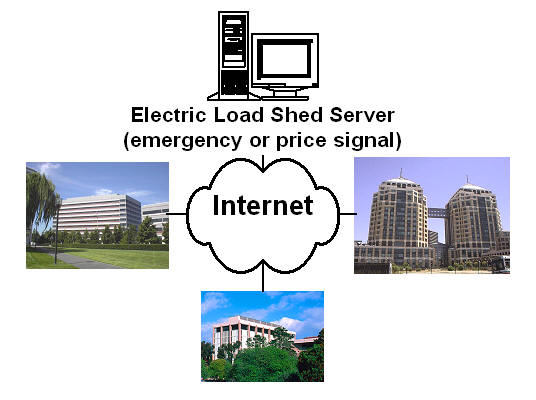July 2004
![]()
AutomatedBuildings.com
[an error occurred while processing this directive]
(Click Message to Learn More)
July 2004 |
[an error occurred while processing this directive] |
|
|

Lawrence Berkeley National Laboratory (LBNL) is recruiting energy and facility managers of large facilities to participate in the 2004 Automated Demand Response (Auto-DR) research project. This project builds on the methods used in LBNL’s 2003 Auto-DR tests.
|
|
|
|
|
|
|
|
|
|
|
|
|
|
|
|
|
|
|
|
|
|
|
[an error occurred while processing this directive] |
Background: The California Energy Commission and LBNL are studying the ability of facilities to reduce electricity demand temporarily through implementation and testing of Auto-DR. Auto-DR is being evaluated in terms of its potential to flatten out the grid load shape on peak days, help avoid blackouts like those that occurred in California (2001) and the Northeast (2003), and lower costs to ratepayers. Demand response has been identified as an important element of the State of California’s Energy Action Plan, which was developed by the California Energy Commission (CEC), California Public Utilities Commission (CPUC), and Consumer Power and Conservation Financing Authority (CPA).
Benefits to Participants: The Auto-DR tests may help prepare your facility and staff for current and future programs that offer financial incentives for DR. Results from the test will be presented at various conferences, and in trade and academic journals.
Site requirements:
Commercial and industrial sites in California.
Connected loads of greater than 200 kW per site, or organizations with aggregated loads greater than 200 kW.
Baseline technical requirements:
Functional control system (EMCS, pneumatic control system or advanced Web-enabled Energy Information Systems (EIS)).
The means to measure and achieve either whole building or component level electric loads on 15-minute intervals. Most facilities of this size already have remotely readable interval meters such as the InterAct II system in PG&E’s territory or the Southern California Edison EnergyManagerSM. Though not required, some systems with near “real-time” electric monitoring will also be selected.
All sites must have access to the Internet (i.e. surf the Web from offices at the site). Having a Web-enabled EMCS or EIS is not required.
Shed Strategies: Strategies such as global zone temperature setpoint setup/setback, duct static pressure setpoint reduction, cooling valve limits, lighting reductions, shutting off non-critical fans or pumps are all valid. Each site’s facility staff should consider these and other strategies that are best suited to their facility. The amount of load shed must be measurable using the metering equipment as outlined above.
Figure 1. Overview of system architecture

Test Description:
A client software application for each site polls a common Internet-based server to obtain the latest value of the electric shed signal generated by LBNL.
The price signal remains in the “normal” range during most hours of the test. Three to five times during an agreed upon test period, the signal will change to a value that calls for an electric shed.
The software application then commands the HVAC, lighting or other equipment at the site to reduce demand. This command is usually transmitted from the client application computer to the EMCS via an EIS gateway or Internet enabled relay.
Each test will last between one and four hours. The number of tests will be minimized to reduce the burden on facility occupants or other business processes.
[an error occurred while processing this directive] Implementation and staff requirements: A hand-off package and technical support will be available to each project team (In some cases an Internet controlled relay may also be provided). The hand-off package will include examples of how to make simple programming changes to the EMCS to enable the desired results.
Payment: The research team is providing the hand-off package and technical support to each facility. The facilities are responsible for the labor required to implement this project at their site.
Schedule:
Site recruitment and selection during June 2004
System development in July 2004
Auto-DR tests in August and September 2004
To sign-up and/or request more information, please contact:
Dave Watson
510 486-5562
dswatson@lbl.gov
Nance Matson 510 486-7328
nematson@lbl.gov
Or send e-mail to:
demandresponse@lbl.gov
This project will be conducted through the PIER Demand Response Research Center (see drrc.lbl.gov ). For more information on Energy Information Systems see http://buildings.lbl.gov/hpcbs/Pubs.html. Web-based Energy Information Systems for Energy Management and Demand Response in Commercial Buildings, Motegi, N., M.A. Piette, S. Kinney, and K. Herter, Lawrence Berkeley National Laboratory. April 2003, LBNL Report 52510.
[an error occurred while processing this directive]
[Click Banner To Learn More]
[Home Page] [The Automator] [About] [Subscribe ] [Contact Us]